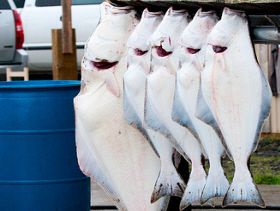 laws of supply and demand are resulting in a nice pay day for Alaska halibut and sablefish harvesters. Prices for both fish are up by more than a dollar a pound compared to the same time last year.
laws of supply and demand are resulting in a nice pay day for Alaska halibut and sablefish harvesters. Prices for both fish are up by more than a dollar a pound compared to the same time last year.Fresh halibut has been moving smoothly and demand is steady since the fishery opened in early March, said a major Kodiak buyer, where dock prices were reported at $6 a pound for ten to 20 pounders, $6.25 for halibut weighing 20 to 40 pounds, and $6.50 for “40 ups.”
At Homer and in Southeast Alaska, halibut prices have yet to drop below six bucks a pound, said local processors. Dock prices at Homer last week ranged from $6.50 to $7.00 per pound “for very small loads.”
At Southeast, after reaching a high of $6.75 at Easter, halibut prices were $6.60/$6.40 /$6.10 per pound. Processors are reporting “strong halibut catches and lots of nice fish”. The fresh fish is being flown out almost daily from Southeast and distributed in small lots to markets all over the US. Alaska’s total halibut catch this year is close to 16 million pounds.
The higher halibut prices are likely due to the slower pace of the fishery and less fish crossing the docks. Just over 3.5 million pounds had been landed statewide by May 2 out of a nearly 19 million pound catch limit. Top ports for halibut landings were Seward, Homer, Petersburg and Kodiak.
For sablefish, commonly called black cod, longliners are benefitting from “bare cupboards” and strong demand by buyers in Japan, where the bulk of Alaska’s catch goes. Last year, holdovers in freezers pushed prices down 40% to the $5 to $3 per pound range, depending on fish size.
Black cod is usually priced in five weights, ranging from under three pounds to over seven pounds. At Kodiak the breakout was $6.75 - $5.75 - $5.00 -$4.50 and $4.00. Sablefish prices at Homer were running between $4 and $7 a pound. Southeast processors reported prices at $5.30 to $7 a pound at the docks. Alaska’s sablefish catch this year is about 24 million pounds. Most deliveries are going to Seward, followed by Kodiak and Homer.
Snails on acid - Argue all you want about climate change – even a Toys R Us chemistry set will prove that the oceans are more acidic. Now, a federal study is revealing its first findings on how corrosive oceans are affecting sea life – and it points to big trouble for pink salmon.
NOAA announced last week the first evidence showing the high acid content in the Pacific Ocean is dissolving the shells of tiny free-swimming snails called pteropods. The tiny snails make up 45 percent of the diet of pink salmon; they also are a food source for herring and mackerel.
Researchers at NOAA’s Pacific Marine Environmental Lab in Seattle said the percentage of pteropods with corroded shells has doubled in near shore areas since the pre-industrial era. Study co-author William Peterson said scientists did not expect to see pteropods being affected to this extent for several decades. The number of snails with dissolving shells is likely to triple by 2050, he said, when waters close to shore are projected to be 70 percent more corrosive.
The problem stems from carbon dioxide being released into the air by human industry that is absorbed by the ocean and becomes carbolic acid. When you combine the corrosion with increasing ocean temperatures, the entire marine mix is affected.
“With a 10 percent increase in water temperature, which is what most people fear in terms of climate change, there would be about a 3 percent drop in mature salmon body weight,” said Bob Foy, director of the NOAA lab at Kodiak. “On the other hand, a 10 percent drop in pteropod production would lead to about a 20 percent drop in body weight. Obviously, the system is fairly dynamic, but the loss of pteropod population would be extremely detrimental to pink salmon.”
Pinks make up Alaska’s largest salmon fishery by volume and second only to sockeyes in value. Last year’s pink salmon catch was a record 219 million fish valued at $277 million at the docks. NOAA research finds acid dissolving snail shells





